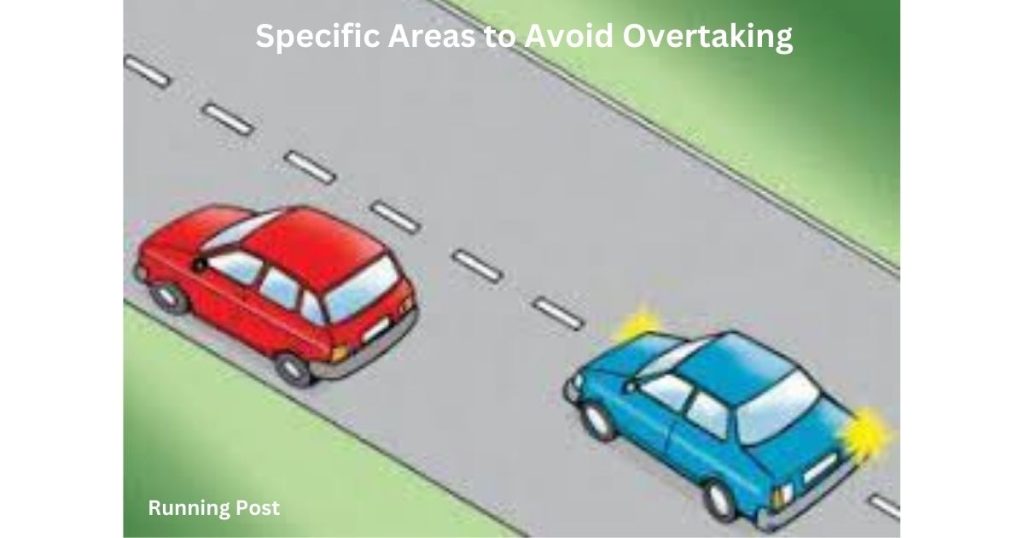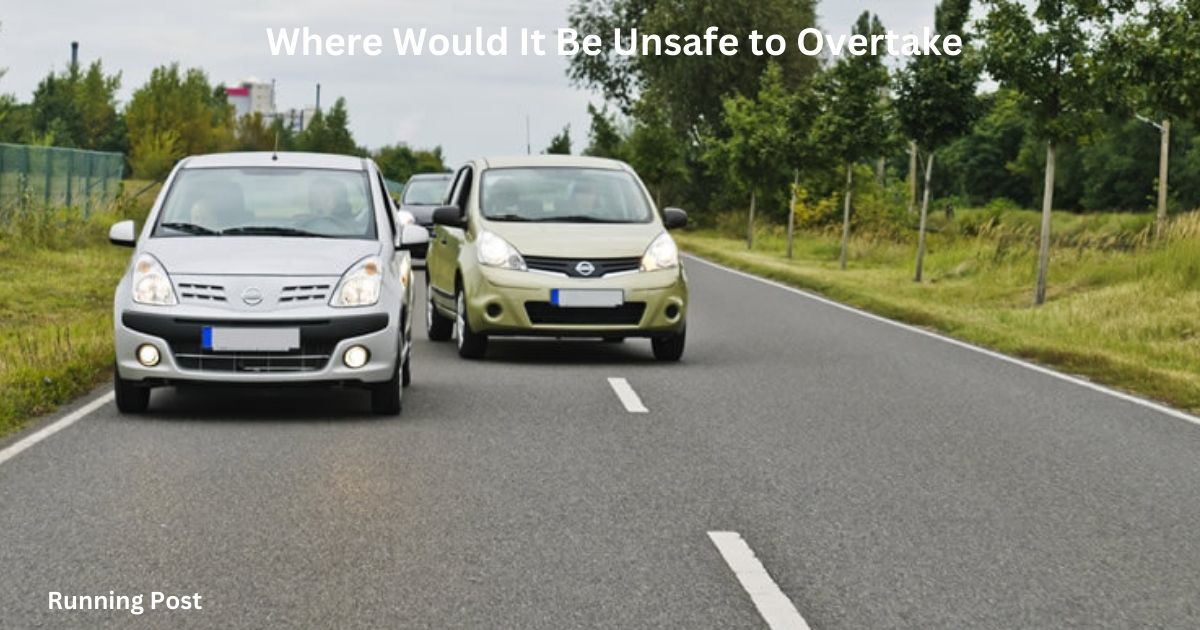| A: On a clear day | B: On a dry, sunny day | C: Approaching a junction | D: On a single carriageway |
Where Would It Be Unsafe to Overtake? Overtaking is a maneuver that must be executed with care and consideration of road conditions and surrounding traffic. Knowing where it’s unsafe to overtake helps prevent accidents and ensures a safer driving experience. Unsafe overtaking typically occurs in situations where visibility, road conditions, or traffic patterns pose significant risks.
General Unsafe Overtaking Situations
On Narrow Roads
Overtaking on narrow roads can be extremely hazardous due to the limited space available. Narrow roads often have minimal room for two vehicles to pass each other comfortably, making overtaking risky. If you attempt to overtake on a narrow road, you may inadvertently force another vehicle off the road or into oncoming traffic. Additionally, the reduced space means that there is less margin for error, increasing the likelihood of collisions.
- Limited space: Increases the risk of side-swiping other vehicles.
- Potential oncoming traffic: Narrow roads often have less visibility for oncoming vehicles.
In Poor Visibility Conditions
Visibility plays a critical role in safe overtaking. When driving in fog, rain, or at night, your ability to see other vehicles and potential hazards is significantly reduced. Overtaking in such conditions is dangerous because you might not see obstacles or oncoming traffic in time to react. Additionally, your vehicle’s headlights and taillights might not adequately illuminate the road or alert other drivers to your presence.
- Reduced sight distance: Makes it difficult to assess whether it’s safe to overtake.
- Increased stopping distances: Poor visibility extends the distance needed to stop safely.
On Blind Corners
Blind corners are particularly treacherous when it comes to overtaking. The inability to see around the corner means you cannot anticipate oncoming traffic or potential hazards. Attempting to overtake in such situations can lead to serious accidents, as you might collide with vehicles or obstacles that are hidden from view until the last moment.
- Lack of visibility: Hinders your ability to see traffic coming from the opposite direction.
- Unpredictable situations: Can result in sudden and unforeseen collisions.
Specific Areas to Avoid Overtaking

Near Pedestrian Crossings
Pedestrian crossings are high-traffic areas where people are frequently crossing the road. Overtaking near these crossings is dangerous because you might not notice pedestrians waiting to cross or those already crossing. Even if you’re aware of the crossing, overtaking could force pedestrians into a dangerous situation or result in accidents if they are not seen in time.
- High foot traffic: Increases the risk of hitting pedestrians.
- Limited visibility: Can obscure your view of people using the crossing.
In School Zones
School zones are particularly sensitive areas where overtaking should be avoided. These zones are characterized by high pedestrian activity, including children who might not be as aware of traffic rules. Overtaking in these areas increases the risk of accidents due to the unpredictable behavior of young pedestrians and the frequent stopping of vehicles to pick up or drop off students.
- Increased pedestrian activity: Adds to the risk of accidents.
- Unpredictable movements: Children and parents may enter the road unexpectedly.
On Hills and Inclines
Hills and inclines present unique challenges for overtaking. When driving uphill, your vehicle’s acceleration might be compromised, making it harder to complete an overtaking maneuver quickly. On downhill slopes, higher speeds can make overtaking even more dangerous as you might not have enough time to react to oncoming traffic or road hazards.
- Reduced acceleration: Slows down overtaking on inclines.
- Increased speed: Downhill slopes can make overtaking more hazardous.
Why Can It Be Dangerous to Overtake?
Risk of Collisions
Overtaking inherently involves a risk of collision, especially if done in unsafe conditions or areas. The danger arises from the need to move into oncoming traffic lanes, which can lead to head-on collisions if the overtaking maneuver is not completed quickly or safely. The risk is exacerbated when overtaking on narrow or poorly visible roads.
- Head-on collisions: Increased risk when overtaking in unsafe conditions.
- Compromised maneuvering space: Can lead to side-swiping or other collisions.
Impact on Other Road Users
Unsafe overtaking can have significant consequences for other road users, including pedestrians, cyclists, and other drivers. A driver overtaking unsafely might not only put themselves at risk but also endanger others who are sharing the road. For instance, overtaking near a bicycle lane or pedestrian zone can create hazardous conditions for these vulnerable road users.
- Pedestrians and cyclists: More at risk in unsafe overtaking scenarios.
- Disruption of traffic flow: Can cause confusion and accidents among other drivers.
Legal Consequences
In many regions, unsafe overtaking is not just a safety issue but a legal one. Drivers who overtake in prohibited or dangerous conditions may face fines, points on their license, or even more severe penalties if an accident occurs. Understanding the legal implications emphasizes the importance of adhering to road safety rules.
- Fines and penalties: Legal repercussions for unsafe overtaking.
- Points on license: Can affect your driving record and insurance rates.
Where Should a Driver Overtake?
On Clear, Straight Roads
The safest conditions for overtaking are on clear, straight roads where visibility is optimal. These roads provide a clear view of the road ahead, allowing drivers to assess whether it’s safe to overtake without encountering oncoming traffic or other obstacles. Straight roads also offer ample space for completing the maneuver safely.
- Good visibility: Helps in assessing the safety of overtaking.
- Ample space: Reduces the risk of collisions during the maneuver.
When Signaled by Road Markings
Road markings are designed to guide drivers on safe overtaking practices. Solid lines, dashed lines, and specific overtaking zones are indicators that can help drivers understand where overtaking is permitted. Following these markings ensures that overtaking is done in areas designated as safe by traffic authorities.
- Overtaking zones: Clearly marked areas where overtaking is allowed.
- Road markings: Provide guidance on where it is safe to overtake.
When Approaching a Junction
In specific cases, such as when approaching a junction on a one-way street, overtaking is permissible under certain conditions. This is because one-way streets reduce the risk of oncoming traffic, making overtaking safer. However, it’s still important to be cautious and ensure that the maneuver is completed safely.
- One-way street advantage: Reduced risk of encountering oncoming vehicles.
- Caution at junctions: Ensuring safety while overtaking at intersections.
You Also Like It:
Where May you Overtake on a one-way Street
Releated Posts
MAB Instructor Certification: Your Gateway to Professional Crisis Management Leadership
In today’s fast-evolving professional environments—especially in healthcare, mental health, education, and corrections—conflict and aggression can arise without warning.…
Freewayget.com: Your Ultimate Platform for Deals, Discounts, and Digital Products
Introduction to Freewayget.com In today’s fast-paced digital world, finding reliable platforms that offer authentic discounts, deals, and digital…
Affordable & Fast Embroidery Digitizing Services in Your Area
Embroidery digitizing services provide corporations, designers, and people with brilliant embroidery-equipped designs by means of changing art work…
Introduction to hdhub4u nit
In this article, we will delve into the details of hdhub4u nit, exploring its features, benefits, and why…

















